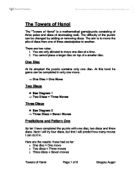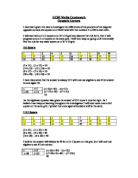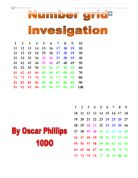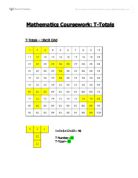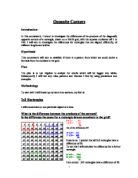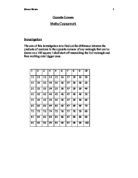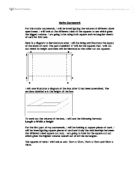To find if a tabloid paper gives a more "easier" read than a broadsheet paper
Maths Coursework Introduction There are many different newspapers; they range from tabloid papers to the broadsheet papers. The tabloids are a lighter read to the more involving descriptive broadsheet papers. Different newspapers are written to suit these preferences. In the tabloid papers the wording used is less profound and therefore more easily understood. Aim To find if a tabloid paper gives a more "easier" read than a broadsheet paper Prediction A broadsheet paper will have more letters on average per word than a tabloid paper. Objectives . To collect data on number of letter per word in two papers. 2. To present data in a meaningful way 3. To interpret and analyse results and diagrams 4. To draw conclusions on analysis, state whether the prediction is correct. Method The data will be collected in-groups as this saves time. Every fourth word in a report will have the numbers of letters counted in it. This should give a good overall view to the word length in a section. Similar sections from each newspaper will be counted as to keep it fair. For example sports will be counted from newspapers, so will economics and politics. This is to give an overall view of the newspapers and so not just one area is studied. From each section the same number of words will be used to keep the investigation fair. Broadsheet Number Of Letters Number Of Times They Appear
Used car prices
As part of my GCSE Statistics coursework investigation, I have been asked to investigate the factors, which affect the price of a car. To do this I have to break the investigation down into smaller questions. From my point of view the following information that we have been given, has very little or no affect on the price of the car, therefore they will not be investigated: * Insurance * Doors * Central locking * Seats * Gearbox * Airbags The question I have chosen, "What factors affect the price of a used car?" now needs to be broken down into sub-questions to find out which factors affect the price of a car the most. The sub-questions are as follows: * How do the make, model and age of a car affect its price? * How does the colour of the car affect the value of the car? * If the car has been serviced, what affect does this have on the price of the car? * How does a cars mileage affect its price? * Does the number of owners affect the car value? * Does the length of a car's MOT affect its value? * If a car has air conditioning, then does its value rise? For this investigation I am going to take a sample size of 60 cars from which I will try and take at least 2 of each car, so that I am able to compare two of the same types of car. However, the sample will not be random if I choose the cars myself. Therefore, to make sure that the sample I choose to use is fair,
The Towers of Hanoi
The Towers of Hanoi The "Towers of Hanoi" is a mathematical game/puzzle consisting of three poles and discs of decreasing radii. The difficulty of the puzzle can be changed by adding or removing discs. The aim is to move the pile of discs from one of three stacks/poles to another. There are two rules: . You are only allowed to move one disc at a time. 2. You cannot place a larger disc on top of a smaller disc. One Disc At its simplest the puzzle contains only one disc. At this level he game can be completed in only one move. ==> One Disc = One Move Two Discs * See Diagram 1 ==> Two Discs = Three Moves Three Discs * See Diagram 2 ==> Three Discs = Seven Moves Predictions and Pattern One So far I have completed the puzzle with one disc; two discs and three discs. Next I will try four discs, but first I will predict how many moves I can do it in. Here are the results I have had so far: o One disc = One move o Two discs = Three moves o Three discs = Seven moves The first thing I notice is that for each extra disc you can find the number of moves by doubling the number needed for the previous disc and the adding one. ==> ( 1 x 2 ) + 1 = 3 ==> ( 3 x 2 ) + 1 = 7 So for four discs I predict I will take 15 moves as that would be the next result in the pattern. ==> ( 7 x 2 ) + 1 = 15 Four Discs * See Diagram 3 ==> Four Discs = Fifteen Moves Predictions and
Towers of Hanoi.
Year 10 GCSE coursework Towers of Hanoi Introduction The aim of this piece of coursework is to complete different investigations. The name of these investigations is the Towers Of Hanoi. I will need to be patient and enthusiastic to complete these testing challenges. Basically I have 4 discs of decreasing radii and 3 towers named A, B and C. I am allowed to move only one disc at a time and I cannot place a larger disc on top of a smaller disc. I have to complete the challenges within a certain amount of goes. I will do 6 investigations using 1, 2, 3, 4, 5 and 6 discs. After I have completed these investigations I will compare them and try to find patterns etc. I will be required to show diagrams, graphs, tables of results and rules. I will also include a conclusion. Investigating some challenges Now I am going to show my the 6 investigations and try to find patterns and rules afterwards Investigation 1 In my first investigation I will attempt to successfully move 4 discs to tower C in the least number of moves. I will now confirm that with four discs it is possible to get from the start (A) to the finish (B) or (C) in a minimum of 15 moves. This is the position I will begin my challenge from. ) 2) 3) 4) 5) 6) 7) 8) 9) 10) 1) 12) 3) 14) 5) Moves: 1-B 2-C 1-C 3-B 1-A 2-B 1-B 4-C 1-C 2-A 1-A 3-C 1-B 2-C 1-C As I confirmed, it is possible to




